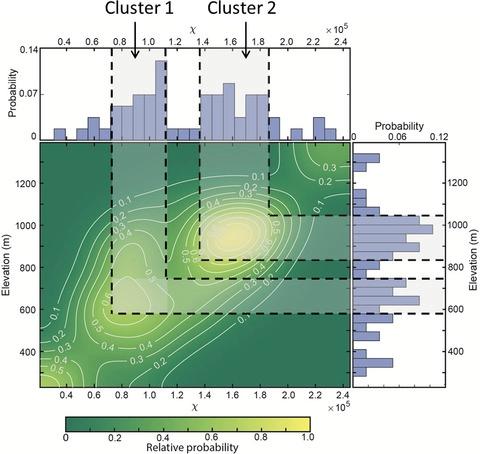当前位置:
X-MOL 学术
›
Basin Res.
›
论文详情
Our official English website, www.x-mol.net, welcomes your feedback! (Note: you will need to create a separate account there.)
Knickpoint morphotectonics of the Middle Shire River basin: Implications for the evolution of rift interaction zones
Basin Research ( IF 3.2 ) Pub Date : 2022-06-23 , DOI: 10.1111/bre.12687 Zuze Dulanya 1 , Sean F. Gallen 2 , Folarin Kolawole 3 , Jack N. Williams 4, 5, 6 , Luke N. J. Wedmore 5 , Juliet Biggs 5 , Åke Fagereng 4
Basin Research ( IF 3.2 ) Pub Date : 2022-06-23 , DOI: 10.1111/bre.12687 Zuze Dulanya 1 , Sean F. Gallen 2 , Folarin Kolawole 3 , Jack N. Williams 4, 5, 6 , Luke N. J. Wedmore 5 , Juliet Biggs 5 , Åke Fagereng 4
Affiliation

|
Tectonic and paleo-environmental reconstructions of rift evolution typically rely on the interpretation of sedimentary sequences, but this is rarely possible in early-stage rifts where sediment volumes are low. To overcome this challenge, we use geomorphology to investigate landscape evolution and the role of different forcing mechanisms during basin development. Here, we focus on the humid Middle Shire River basin, located within the zone of progressive interaction and linkage between the southern Malawi Rift and Shire Rift Zone, East Africa. We used a digital elevation model to map knickpoints and knickpoint morphologies in the Middle Shire River basin and examined the relationships with pre-rift and syn-rift structures within the rift interaction zone. The main axial stream, Shire River, descends steeply, 372 m over a 50 km distance, across exposed metamorphic basement along the rift floor, exhibiting a strongly disequilibrated longitudinal elevation profile with both ‘mobile’ and ‘fixed’ knickpoints. In particular, we identify two clusters of mobile knickpoints, which we interpret as associated with baselevel fall events at the downstream end of the exposed basement that triggered knickpoint migration through the fluvial network since at least the Mid. Pleistocene. We infer that after the integration of the axial stream across the Middle Shire Basin, the knickpoints migrate upstream in response to fault-related subsidence in the Shire Rift Zone. Conversely, the fixed knickpoints are interpreted to reflect local differential bedrock erodibility at lithologic contacts or basement-hosted fault scarps along the basin floor. The results suggest that Middle Shire basin opening, associated with rift linkage, is likely a recent event (at least Mid. Pleistocene) relative to the Late Oligocene activation of Cenozoic rifting in the East African Rift's Western Branch. These findings support the hypothesis that the Western Branch developed from the gradual propagation, linkage and coalescence of initially nucleated distinct rift basins.
中文翻译:

中夏尔河流域的 Knickpoint 形态构造学:对裂谷相互作用带演化的启示
裂谷演化的构造和古环境重建通常依赖于沉积层序的解释,但这在沉积物量低的早期裂谷中几乎不可能。为了克服这一挑战,我们使用地貌学来研究景观演化和盆地发展过程中不同强迫机制的作用。在这里,我们关注潮湿的中夏尔河流域,该盆地位于马拉维裂谷南部和东非夏尔裂谷区之间的渐进相互作用和联系区域内。我们使用数字高程模型绘制了中部夏尔河流域的裂谷点和裂谷点形态,并检查了裂谷相互作用区内裂谷前和同裂谷结构的关系。主要的轴向河流,夏尔河,在 50 公里的距离内陡峭下降 372 米,沿着裂谷底穿过裸露的变质基底,显示出具有“移动”和“固定”拐点的强烈不平衡的纵向海拔剖面。特别是,我们确定了两个移动拐点集群,我们将其解释为与暴露地下室下游端的基准面坠落事件相关联,该事件至少从中世纪开始触发了通过河流网络的拐点迁移。更新世。我们推断,在中部 Shire 盆地的轴向流整合之后,节点向上游迁移,以响应 Shire 裂谷带中与断层相关的沉降。相反,固定拐点被解释为反映了沿盆地底部的岩性接触或基底断层陡坡的局部差异基岩可蚀性。结果表明 Middle Shire 盆地开放,与裂谷连锁有关,可能是最近发生的事件(至少是中更新世),与东非裂谷西部分支新生代裂谷的晚渐新世激活有关。这些发现支持这样的假设,即西部分支是从最初成核的不同裂谷盆地的逐渐传播、连接和合并中发展而来的。
更新日期:2022-06-23
中文翻译:

中夏尔河流域的 Knickpoint 形态构造学:对裂谷相互作用带演化的启示
裂谷演化的构造和古环境重建通常依赖于沉积层序的解释,但这在沉积物量低的早期裂谷中几乎不可能。为了克服这一挑战,我们使用地貌学来研究景观演化和盆地发展过程中不同强迫机制的作用。在这里,我们关注潮湿的中夏尔河流域,该盆地位于马拉维裂谷南部和东非夏尔裂谷区之间的渐进相互作用和联系区域内。我们使用数字高程模型绘制了中部夏尔河流域的裂谷点和裂谷点形态,并检查了裂谷相互作用区内裂谷前和同裂谷结构的关系。主要的轴向河流,夏尔河,在 50 公里的距离内陡峭下降 372 米,沿着裂谷底穿过裸露的变质基底,显示出具有“移动”和“固定”拐点的强烈不平衡的纵向海拔剖面。特别是,我们确定了两个移动拐点集群,我们将其解释为与暴露地下室下游端的基准面坠落事件相关联,该事件至少从中世纪开始触发了通过河流网络的拐点迁移。更新世。我们推断,在中部 Shire 盆地的轴向流整合之后,节点向上游迁移,以响应 Shire 裂谷带中与断层相关的沉降。相反,固定拐点被解释为反映了沿盆地底部的岩性接触或基底断层陡坡的局部差异基岩可蚀性。结果表明 Middle Shire 盆地开放,与裂谷连锁有关,可能是最近发生的事件(至少是中更新世),与东非裂谷西部分支新生代裂谷的晚渐新世激活有关。这些发现支持这样的假设,即西部分支是从最初成核的不同裂谷盆地的逐渐传播、连接和合并中发展而来的。



























 京公网安备 11010802027423号
京公网安备 11010802027423号